Growing Venus flytrap does not have to be hard. The basis of taking care of Venus flytraps starts with building a proper setup and a systematic care process. Your main goal is to mimic their original habitat. Venus flytraps are native to South Carolina and North Carolina in the United States. They only grow naturally in those two states. However, it is possible to grow venus flytraps all over the world.
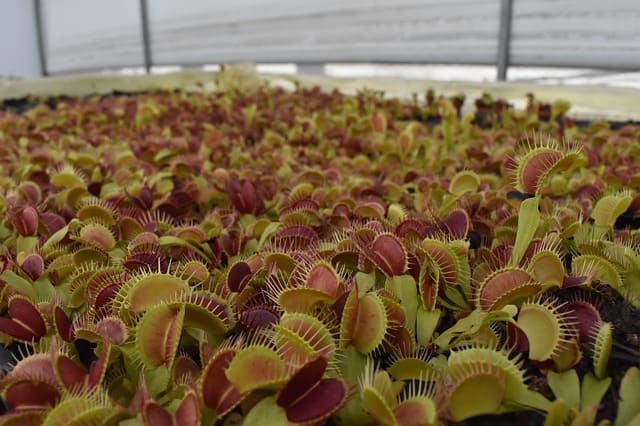
This article contains some essential information to build a Venus flytrap setup and the appropriate care instructions and consideration. Read on and learn more about Venus flytraps.
Elements to Grow Venus Flytraps
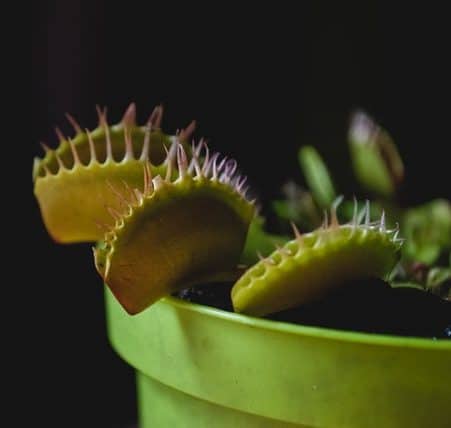 In the Carolinas, Venus flytraps grow with an abundance of sunlight in humid terrain, which lacks nutrients. Before you build a setup for your plants, make sure to go over this list of essential elements.
In the Carolinas, Venus flytraps grow with an abundance of sunlight in humid terrain, which lacks nutrients. Before you build a setup for your plants, make sure to go over this list of essential elements.
Important Elements
Light: These carnivorous plants need an abundance of light. Venus flytraps require 12 hours of sunlight every day. They can live under partial shade. However, they must always receive at least 4 hours of direct sunlight. If you live in a sunny area, pick a sunny window or balcony, and take advantage of natural light. If your home town lacks natural light, you can always employ artificial lighting. A quick online search can get you in the right direction. But, generally, high output fluorescent lights are suitable for Venus flytraps.
Water: Venus flytraps require a very humid environment. You must water them consistently and never let the soil be dry. Also, you can’t use tap water or any water with salts and minerals (your plant will die). Instead, use rainwater, distilled water, or revert osmosis water.
Soil: The optimal ground for Venus flytraps is nutrient-free and with good drainage. There are many specialized carnivorous plant blend soils in the market. These soils are not appropriate for other plants due to their lack of nutrients, but they are perfect for Venus flytraps. You can buy the soil or make it yourself. Most growers utilize a mix of these components: Long-fibered sphagnum moss, sphagnum peat moss, sand, and perlite.
Elements to Avoid
Fertilizer: There is no need to fertilize Venus flytraps. Venus flytraps can not handle minerals. Fertilizers can weaken and eventually kill Venus flytraps.
Stress: Avoid stress due to constant movement and rough handling. Place your plant in a strategic area where it won’t need to be under continuous movement. Movement can produce strain and cause leaves to wither. Also, do not manually play with the plant and activate the plant’s traps. Venus flytraps utilize a lot of energy controlling those traps.
Extreme temperatures: Venus flytraps need sunlight, but they can dry out if they are placed under intense heat (be careful with that extremely hot window!). Also, during winter, Venus flytraps should experience colder weather, but they should not freeze completely.
Build the Setup
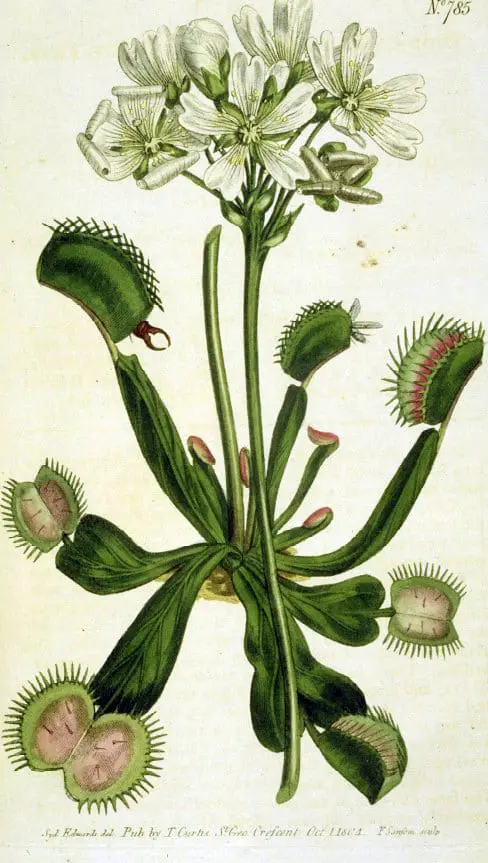
Now, you are ready to build a layout, make sure you have the essential elements: light (natural or artificial), water (distilled, revert osmosis or rain), Venus flytrap soil, your plants (or seeds), and a pot. The best containers for Venus flytraps are made of plastic, they are proportional to the plant’s size, and they have multiple holes.
Let’s assume you are starting to grow Venus flytraps, and you have bought the plants (probably a few years old). First, start by soaking the soil in the mineral-free water. Once the ground is saturated, add it in the pot. Now, dig a hole with enough spacing for the plant’s roots and center bulb and introduce it in the soil.
Venus flytraps have a central stem that connects to the underground roots. From the center, branches spur to become traps. The bottom center bulb is of a light pinkish color. All that area must be underground. Place your plant carefully and cover the roots and center bulb with the soil. In the end, only the green parts of your plant should be visible. Make sure the soil is still moist and place your Venus flytrap under appropriate lighting.
It can be challenging to keep the soil wet at all times; for that reason, I recommend using a saucer or plate to hold extra water. Like the image below, you can place the pot in a shallow container and fill the container with water. Then, you will have water reserves, and your soil is less likely to dry out.
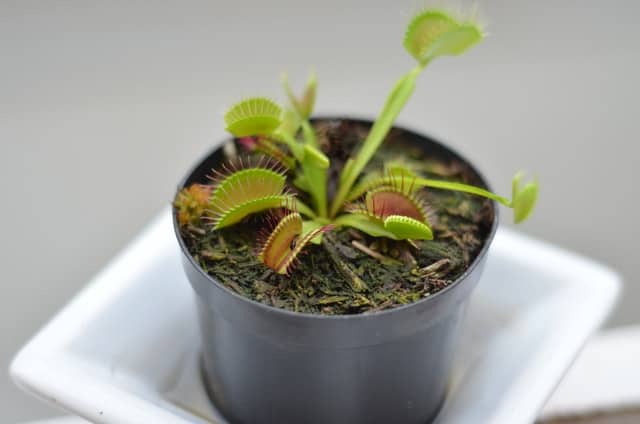
If you have multiple plants, do not overcrowd one pot with various plants—instead, plant one Venus flytrap per cup. Once your plant has outgrown the container, you can consider repotting.
Growing Venus Flytraps from Seeds
Growing Venus flytraps from seeds will allow you to experience the full growth cycle of Venus flytraps. The process of Harvesting Venus flytraps from seeds is similar to the method described above. First, you will need the same necessary materials: light (natural or artificial), water (distilled, revert osmosis or rain), Venus flytrap soil, seeds, and a pot.
Since you will be working with seeds, you must be thorough in preparing the soil. The soil must be completely soaked in water. You know it is ready when you press the ground and water emerges (like when you press a sponge full of water). Then, go ahead and sow the seeds in the soil. Do your best to sprinkle them separate enough, so they have enough space to germinate. If you have multiple pots and enough soil, consider dividing your seeds into various batches. After, you can place your containers in different strategic places with enough lighting. With that method, you have higher chances of getting it right!
After a couple of weeks, you should be able to spot the first germinations. Be patient and continue to maintain your seeds on wet soil and under appropriate lighting and temperature. Eventually, you will be able to harvest tiny Venus flytraps. Then, you can transfer your new Venus flytraps to individual pots and continue to care for them as we have learned.
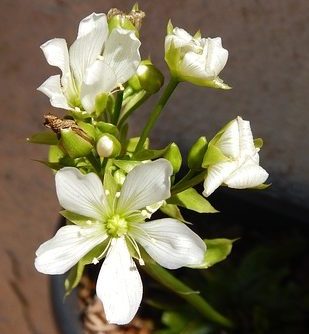
The only step missing to complete the whole lifecycle of Venus flytraps is to produce the seeds. You can harvest Venus flytraps seeds after pollinating their flowers. We have some useful introductory information if you are interested in collecting your own seeds. Read the article below to learn about Venus flytrap flowers and the fertilization process:
Other consideration when growing a Venus flytrap
Feeding: Venus flytraps get nutrients from the insects they capture and consume since the soil they live in is very poor. When you grow Venus flytraps, you must ensure they are catching and consuming bugs. If they are growing outdoors, they should be able to catch their prey. But, if you are growing them indoors, you will have to take care of the feeding. Learn about the feeding process with this article: How to Feed a Venus Flytrap?
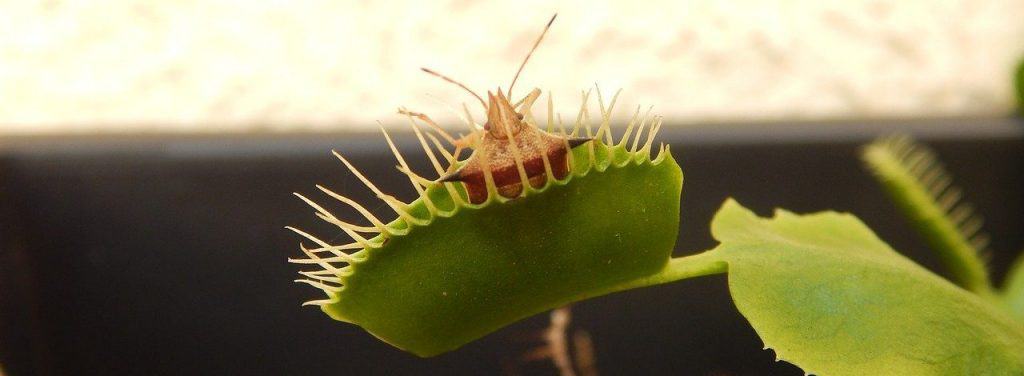
Dormancy: In their natural habitat, Venus flytraps undergo a dormancy process every year (3 – 4 months). During late fall or winter, when temperatures drop, Venus flytraps will go dormant. Your plants might chanrge drastically during this period. First-time owners sometimes think their plans ae dying, but they just dormant. Even though you can skip dormancy without immediately killing your plant, the process is a crucial stage for the plant’s development. For that reason, you should make sure your Venus flytrap experiences dormancy every year. Here is more information on Venus flytrap dormancy and how to achieve it: The Complete Venus Flytrap Care Instruction.
The stages of growing Venus Flytrap
The germination process takes 1 to 5 weeks. Then, the young Venus flytraps continue to grow for several years. Venus flytraps reach maturity after 2 to 4 years. During winter, Venus flytraps experience dormancy. During such a period, they reduce in size. After, during spring, Venus flytraps recover their size and start to flourish.
Ultimately, how big can a Venus flytrap get?
All science fiction movies aside, Venus flytraps are not large plants Horizontally, the expected mature size of Venus flytraps is 5 inches (12.7 cm) in diameter. Vertically, Venus flytraps can be as tall as a foot (30 cm). And, the size of each trap can reach a size of one inch (2.5 cm) long. Venus flytraps are not impressive due to their size, but to their unique trapping mechanism that has captivated people for ages.
So, is growing Venus flytrap hard?
Personally, I do not believe growing Venus flytraps is particularly hard. I struggle to keep succulents or cacti alive. Most of the time is because I water them too much or too little. Venus flytraps, on the other hand, require a specific type of water (nutrient-free), but aside from that, you know how much to water them. The answer is always: “a lot.” If you are a first-time grower, focus on building a proper environment for your plants with all the right elements and learn about their needs. Also, be attentive to sudden changes in your Venus flytrap and research if you are unsure about the solution.
Sources:
- https://www.fws.gov/southeast/wildlife/plants/venus-flytrap/
- D’Amato, P. (2013). The Savage Garden. Berkeley, Unites States: Ten Speed Press.
- https://carnivorousplantnursery.com/blogs/potting-carnivorous-plant/how-to-pot-a-carnivorous-plant

